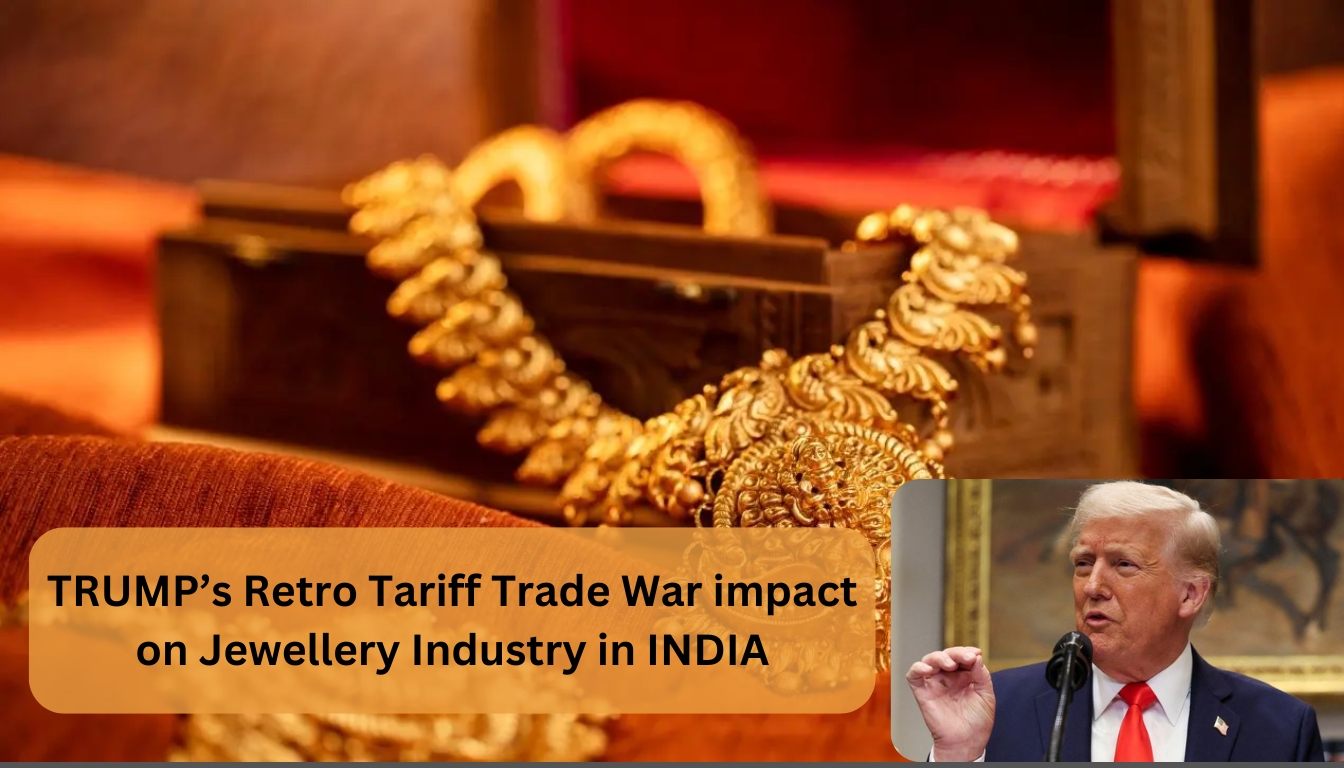Trump’s retro tariff trade war has hit the jewellery industry in India hard. It has led to a 25% tariff on imports from Canada and Mexico. There’s also a 10% duty on goods from China. This has brought new challenges and chances for the industry.
The jewellery sector is key to India’s economy. Trump’s tariffs have raised costs by 10%. This could mean higher prices for consumers, especially with inflation still high. It’s important to keep up with the latest on the retro tariff trade war.
Dealing with the retro tariff trade war is complex. It’s causing ups and downs in metals markets, affecting jewellery sales. The situation with Trump’s tariffs on India’s jewellery industry is intricate. It’s crucial to understand these impacts to make smart choices.
Key Takeaways
- The retro tariff trade war has led to a 25% tariff imposed on imports from Canada and Mexico, and an additional 10% duty on goods imported from China.
- The jewellery industry in India is facing a 10% increase in costs due to tariffs, which may lead to increased consumer prices.
- The impact of Trump’s retro tariff trade war on the jewellery industry in India is a pressing issue, with potential volatility in metals markets affecting jewellery sales.
- The jewellery industry impacts are far-reaching, and it’s crucial to stay informed about the latest developments in the retro tariff trade war.
- Understanding the jewellery industry impacts is vital for making informed decisions and navigating the complexities of the retro tariff trade war.
Understanding Trump’s Retro Tariff Trade War
The trade conflict between the US and countries like India has big india trade war repercussions. To grasp the start of this fight, we must examine the trump’s tariff effects and their impact on global trade. This war is fueled by political trade policies, causing tariffs on many countries.
The US has slapped tariffs on over $360 billion worth of Chinese goods, with a 20% average tariff rate. This has cut Chinese exports to the US, with China’s export share to the US falling from 19% in 2018 to 15% in 2022.


Industries hit hard by the trade war include light manufacturing, textiles, steel, and computers. The rule on small packages under $800 has also changed, affecting low-value exports. Knowing when and how tariffs were introduced is key to understanding the trade war’s impact.
- The US imposed tariffs on over $360 billion worth of Chinese products.
- The average tariff rate on Chinese goods is around 20%.
- The share of China’s exports going to the US has dropped from 19% in 2018 to 15% in 2022.
The political trade policies have greatly influenced the trade war. The US has suggested raising tariffs on Chinese imports by 60% or more. This has sharply reduced Chinese exports to the US. The trump’s tariff effects have hit many sectors, including India’s jewellery industry.
The Global Jewelry Market Landscape
The global jewelry market is complex and always changing. It’s shaped by many factors. Understanding these trends and challenges is key to success. The international trade conflict has greatly affected the industry, causing issues with tariffs and trade restrictions.
In India, the jewelry market is booming. It’s expected to grow by 20% each year for the next two years. This growth is due to more people wanting jewelry and a growing middle class. Success factors include:
- Increasing demand for jewelry, especially in the organized sector
- Growing middle class and rising disposable incomes
- Government support for the industry and exporters
The international trade conflict has hit the global jewelry market hard. Businesses face higher costs and less demand. But, the Indian market has shown it can adapt. It’s exploring new markets and opportunities. Knowing the current market and future challenges is crucial.
Impact of Trump’s Retro Tariff Trade War on the Jewellery Industry in India
The trade war started by Trump has hit the jewellery industry in India hard. The economic impact on jewellery is a big worry. The india jewellery market has seen ups and downs, with export numbers changing and prices of raw materials going up.
Recent numbers show a 5-10% jump in import costs for gold and diamond jewellery. This has made things more expensive for buyers. It has also cut down on the demand for some jewellery types.
Some major effects of the trade war on India’s jewellery industry are:
- Increased import costs for gold and diamond jewellery
- Fluctuations in export numbers
- Price increases in raw materials
The india jewellery market is worth about $70 billion as of 2023. The trade war has really hurt the industry. It has affected the jobs of around 1.3 million people in India.
Gold Market Volatility and Its Implications
The gold market has seen a lot of ups and downs, affecting the jewelry industry in India. The economic impact on jewellery is a big worry. Gold price changes can hurt the industry’s profits. Recently, the gold price went up to ₹78,647.00, a rise of ₹491.00.
The india manufacturing sector impact is also important. The manufacturing part of the jewelry industry is key. Changes in the gold market can affect its growth. It’s vital to know the current trends and their effects.
Several factors have led to the gold market’s volatility. These include:
- Geo-political uncertainties
- Macro-economic factors
- Changes in global demand and supply
As the gold market stays volatile, the jewelry industry in India needs to be ready. It’s important to understand the economic impact on jewellery and the india manufacturing sector impact. This way, the industry can make smart choices and handle the challenges of gold market volatility.
Shifting Trade Partners and New Alliances
The ongoing trade war between India and other countries has changed the way trade works. The tariffs imposed by the US have pushed industries to look for new markets. This has led to a big change in who they trade with.
In the jewelry world, this change has brought new chances for Indian makers. With tariffs on Chinese goods, many countries now see India as a good place to buy jewelry and accessories.
Some new markets for Indian jewelry are:
- South East Asia
- Latin America
- Africa
These places have a lot of potential for growth. Indian makers are in a great spot to take advantage of this.
Also, the trade war has made new paths for trade. This means less reliance on old markets. New partnerships have been made to help trade and investment grow.
As the trade situation keeps changing, Indian jewelry makers need to stay flexible. By making new alliances and checking out new markets, they can lessen the impact of tariffs. This opens up new chances for growth and success.
| Region | Market Potential | Growth Prospects |
|---|---|---|
| South East Asia | High | Excellent |
| Latin America | Moderate | Good |
| Africa | High | Excellent |
Manufacturing Challenges in India’s Jewelry Sector
The impact of the manufacturing sector on India’s jewelry industry is big. The economic effects on jewelry are a major worry. It’s key to know the challenges that slow down the sector’s growth.
One big challenge is the organized jewellers’ credit metrics. These need to improve with more scale and profit. Also, adopting a new model without much assets is important. This helps us see how the manufacturing sector affects the jewelry industry.
The economic effects on jewelry are also tied to gold prices. Gold prices have gone up by about 28% from January to October 2024. This change affects the manufacturing sector a lot. So, it’s vital to look at the manufacturing sector’s impact when we talk about the economic effects on jewelry.
- Adopting an asset-light model for expansion
- Improving credit metrics through rising scale and absolute profit
- Monitoring gold prices and their impact on the manufacturing sector
By understanding the manufacturing sector’s impact and the economic effects on jewelry, we can face the challenges better. This helps us make smart choices to grow and succeed in the jewelry industry in India.
Cost Implications for Indian Jewelers
Trump’s retro tariff trade war has hit the jewellery industry in India hard. It has led to a 10% rise in the cost of raw materials. This has made production more expensive and disrupted supply chains.
This cost hike has made many Indian jewelers rethink their operations. For example, a 25% tariff on Chinese products has raised the total duty to 36%. This has cut into the profits of many jewellery businesses.
Indian jewelers face several big challenges:
- Production cost changes: Increased cost of raw materials and labour
- Supply chain disruptions: Delays in sourcing and importing raw materials
- Operational adjustments: Need to absorb increased costs or pass them on to consumers
In summary, the cost implications for Indian jewelers are huge. The industry must find ways to adapt and stay competitive in the India jewellery market.
Consumer Impact and Market Response
The india jewellery market has seen big changes because of the international trade conflict. Now, many people are looking for cheaper and eco-friendly options.
Recent data shows the organised jewellery sector’s revenue is growing fast. It’s expected to grow by 20% each year until FY29. This growth is thanks to more people wanting gold and other precious metals, and the rise of online shopping.
Several factors have led to these changes in the india jewellery market. These include:
- Lower customs duty on gold, which has led to more legal imports and less under-caratage
- The market value of the Indian jewellery industry, which is over INR 6 trillion
- More people joining gold schemes, which could affect profit margins
The international trade conflict has also affected the india jewellery market a lot. Proposed tariffs on goods from China and other countries could be as high as 100 percent. This has made things more expensive for both jewellers and customers. Many businesses have had to change how they operate because of this.
Despite these challenges, the india jewellery market is still expected to grow a lot. This growth will come from more people wanting gold and other precious metals. As the market keeps changing, it’s crucial for jewellers to keep up with new trends and what customers want.
Digital Transformation in the Jewelry Trade
The trade war under Trump has changed how businesses work in the jewelry industry in India. The market is growing, and companies are turning to digital solutions to keep up. This shift has been big, helping them deal with the trade war’s effects.
Online shopping is a big reason for this change. Jewelry companies are now using digital platforms to reach more people. They’re making websites easy to use, using social media, and marketing online. This makes the jewelry market in India more digital, with more people buying online.
Technology is also key in this digital shift. Tools like data analytics and artificial intelligence help improve how businesses run. They make customer experiences better and help companies stay ahead in the market.
Some good things come from going digital in jewelry:
- More people see your business online
- Customers have a better experience
- Businesses work more efficiently
- Decisions are made with better data
As the jewelry industry grows, staying updated is crucial. Embracing digital change and new tech helps companies succeed. It also helps them handle the economic challenges from the trade war.
Government Support and Policy Measures
The trade war with India has hit the jewelry industry hard, especially with Trump’s tariffs. But the government is stepping in to help. They’re offering funding and making the business environment better. They also have policies to boost exports and cut imports.
The government has cut the customs duty on gold from 15% to 6%. This move is expected to help the industry grow. The organized jewelry sector is set to grow by 20% each year from FY25 to FY26. By FY24, it will make up 40% of the market, up from 30% in FY21.
These changes have made it easier for the organized industry to thrive. They have better access to funding and stronger corporate governance. The trade war has also made more people join gold schemes, which are less profitable but growing.
Despite the challenges, the industry’s profit margins are expected to recover by FY26. This is thanks to economies of scale. The government’s support has been key in helping the industry grow. It’s important to keep these efforts going to overcome the hurdles caused by tariffs and other issues.
Competitive Advantage of Indian Jewelry Sector
The Indian jewelry sector stands out due to its unique strengths. These include traditional craftsmanship, innovative designs, and cost efficiency. Understanding these aspects is key to grasping the sector’s resilience against Trump’s trade war.
Traditional Craftsmanship and Innovation
India’s jewelry market is celebrated for its skilled artisans. Their expertise, combined with new designs, ensures top-notch jewelry. This has helped the sector maintain its edge despite economic challenges.
Cost Effectiveness
Cost efficiency is another pillar of India’s jewelry sector. It produces quality jewelry at lower prices, attracting global buyers. This cost advantage is expected to boost the sector’s growth further.
In summary, the Indian jewelry sector’s competitive edge is crucial for its success. As you explore the effects of Trump’s trade war, recognizing this advantage is vital for staying competitive.
Future Trade Projections and Market Outlook
Looking ahead, the jewelry industry in India faces challenges from the india trade war repercussions and trump’s tariff effects. The ongoing international trade conflict also plays a role.
Despite these hurdles, the industry is expected to see strong growth. It’s set to grow by 17% each year until FY26. This growth will come from a rising demand and a growing middle class.
Several factors will shape the future of trade and the market. These include:
- Government policies and support for the industry
- Technological advancements and innovation
- Changing consumer preferences and demand
- Global economic trends and trade agreements
In summary, the jewelry industry in India has a bright future ahead. It’s set for growth and expansion. But, it’s important to keep an eye on the india trade war repercussions, trump’s tariff effects, and international trade conflict. This will help make smart decisions and adapt to the changing market.
Adaptation Strategies for Jewelry Businesses
The impact of Trump’s retro tariff trade war on the jewelry industry in India is still being felt. Businesses must adapt to survive. The cost of raw materials for jewelry manufacturers in India has gone up by 10%.
To deal with this, companies can diversify their supply chains. They can also invest in new business models.
Some key strategies for adaptation include:
- Diversifying product lines to reduce dependence on affected materials
- Exploring new markets and trade partnerships to offset losses
- Investing in digital transformation to enhance operational efficiency and customer engagement
The India jewelry market is expected to grow. Exports to the UAE could surge by $10 billion annually with no duty. Jewelry businesses can grow by adopting new models and managing risks.
Understanding the impact of Trump’s trade war on the jewelry industry in India is key. By implementing effective strategies, businesses can overcome challenges and seize opportunities in this complex economic landscape.
International Market Positioning
Understanding the india trade war repercussions is key in the jewelry industry. The trump’s tariff effects have made things tough for exporters. Yet, they also open doors for growth and expansion.
The international trade conflict has changed how we trade globally. Some countries are seeing benefits. For example, the Indian glove industry hopes to thrive because of the US-China trade war. The Indian jewelry industry can also use this chance to boost its international market positioning.
Some important stats to keep in mind are:
- Organised jewellery sector revenue growth forecasted at 20% year-on-year (yoy) in FY25 and 17% yoy in FY26
- Share of the organised sector in the Indian jewellery industry increased from 30% in FY21 to 40% in FY24
- Customs duty on gold reduced from 15% to 6%
By grasping the india trade war repercussions and trump’s tariff effects, you can plan to lessen risks and seize new chances. This will help you enhance your international market positioning and spur growth in the competitive jewelry market.
Conclusion: Navigating the New Normal in India’s Jewelry Trade
The impact of Trump’s retro tariff trade war on the jewellery industry in India is still being felt. Yet, the Indian jewelry sector is showing great strength. Despite the economic impact on jewellery, the India jewellery market is expected to grow by 17% each year in FY26.
Indian jewelers need to find new ways to succeed. They should use their traditional skills, design talent, and low costs to their advantage. By reaching out to new markets and improving their supply chains, they can handle changes in policies and market ups and downs.
With the right government support and their own strengths, India’s jewelry trade has a bright future ahead.














